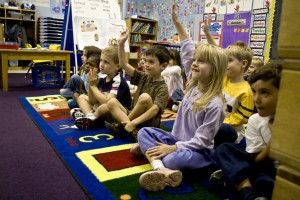Earth’s climate is regulated by a number of components, including the atmosphere, oceans, land, ice, clouds, the Sun, and living organisms. The complex interactions among these components are beyond what is expected of an elementary science curriculum. Instead, young students should learn about the components separately, setting the stage for middle and high school, when these components are examined as a system.
Here we’ve highlighted lessons about weather, water and the water cycle, oceans, and Earth’s atmosphere. For each science lesson, we’ve included the appropriate content standard from the National Science Education Standards. You can read the entire National Science Education Standards online for free or register to download the free PDF. The content standards are found in Chapter 6.
WEATHER
Weather 1: Weather Patterns (Grades K-2)
In this lesson, students keep daily records of temperature, precipitation, and wind. They plot their data and look for patterns of ups and downs without getting deeply into the nature of climate. This lesson meets these content standards of the National Science Education Standards: Science as Inquiry, Earth and Space Science, and Science and Technology.
What Is It Like Outside Today? (Grades K-1)
Students learn to read a thermometer and color paper thermometers to show temperature. Students also begin to explore how a range of temperatures fits into each of the seasons. This lesson meets these content standards of the National Science Education Standards: Science as Inquiry, Earth and Space Science, and Science and Technology.
Calendar & Weather Book (Grades 1-2)
Students will record and track weather patterns daily throughout the year. This activity is well suited for inclusion in a morning meeting or circle time. Focusing on long-term patterns will help students start to develop an understanding of climate. This lesson meets these content standards of the National Science Education Standards: Science as Inquiry, Earth and Space Science, and Science and Technology.
Wonderful World of Weather (Grades 3-5)
This resource includes a series of lessons that allow elementary students to investigate weather phenomena both locally and in other places around the world. Students engage in hands-on activities and real-time data investigations using information available on the Internet. This combination of local and global explorations allows them to relate what they are observing locally to what is happening in remote locations. Through these explorations, students develop a basic understanding of how weather can be described in measurable quantities, such as temperature, wind and precipitation. The lessons meet the Science as Inquiry and Earth and Space Science content standards of the National Science Education Standards.
WATER AND THE WATER CYCLE
Water 1: Water and Ice (Grades K-2)
In this lesson, students will observe, measure, and describe water as it changes state from liquid to solid and back again. This lesson meets the Science as Inquiry and Physical Science content standards of the National Science Education Standards.
Water 2: Disappearing Water (Grades K-2)
Students observe the amount of water in an open container and the amount of water in a closed container over time. Students compare and contrast the sets of observations. This lesson meets the Science as Inquiry and Physical Science content standards of the National Science Education Standards.
Water 3: Melting and Freezing (Grades K-2)
In this lesson, students will investigate how melting and freezing impact three everyday items: water, chocolate, and margarine. They will be introduced to the concept of conservation of matter. This lesson meets the Science as Inquiry and Physical Science content standards of the National Science Education Standards.
The Water Cycle (Grades 3-5)
In this lesson, students review what they know about water and then learn about the water cycle and its key processes that affect our lands, oceans, and atmosphere. This lesson meets the Physical Science and Earth and Space Science content standards of the National Science Education Standards.
Water Cycle: Mobius Strip (Grades 3-5)
In this activity, students create a Mobius strip illustrating the water cycle and then write a paragraph describing the water cycle. This lesson meets the Earth and Space Science content standard of the National Science Education Standards.
OCEANS
Under the Deep Blue Sea (Grades K-2)
This lesson gives students the opportunity to explore oceans and ocean life. After locating the Earth’s major oceans on a world map, students will “dive underwater” to discover the plants and animals that live in the sea. Students will listen to stories and poems with ocean settings and learn about the forms of sea life featured in each. They can add their own artwork and text about ocean animals and plants to an ocean display. Finally, students will engage in various forms of creative writing about the ocean and ocean life. This lesson meets the Life Science and Earth and Space Science content standards of the National Science Education Standards.
Weather and Oceans: Uneven Heating of the Earth (Grades 3-5)
In this lesson, students investigate the heat capacity of water and soil. They discuss how water’s ability to retain heat affects Earth’s ability to support life. This lesson meets the Physical Science and Earth and Space Science content standards of the National Science Education Standards.
Ducks in the Flow (Grades 3-5)
Students learn about ocean surface currents through a story and hands-on exploration. This module meets the Physical Science and Earth and Space Science content standards of the National Science Education Standards.
The Nike Shoe Investigation (Grades 4-5)
This real-data activity involves plotting the locations of recoveries from a 1990 spill at sea of approximately 80,000 Nike shoes. Students use latitude and longitude data to plot the location of the spill as well as places where shoes washed ashore. They connect the points with arrows to visualize currents in the Pacific Ocean. Best completed as a cooperative activity for a whole class or independent work for students needing additional challenge. Note: The questions and exercises included are too advanced for elementary students. This lesson meets the Science as Inquiry and Earth and Space Science content standards of the National Science Education Standards.
ATMOSPHERE
Colorful Candy Clouds (Grades K-5)
This lesson introduces elementary students to the idea that wind is constantly moving and can carry smoke, dust, and gases. One way that early scientists monitored this movement was by watching clouds. Through this activity students get a good look at how air, particles and clouds move in the atmosphere. This lesson meets the Science as Inquiry and Earth and Space Science content standards of the National Science Education Standards.
Properties of Air (Grades 3-5)
In this activity, students conduct investigations that help them develop and refine their ideas about air. At the beginning of the lesson, students write an explanation of what air is. At various points in the lesson, students revisit their explanations and refine them based on the investigations in the classroom. This lesson meets the Earth and Space Science Content Standard of the National Science Education Standards.
Temperature Changes: Atmosphere & Ocean (Grades 3-5)
In this activity, students observe temperature differences of water and air in sunlight and darkness. This lesson meets the Earth and Space Science Content Standard of the National Science Education Standards.
This article was written by Jessica Fries-Gaither. Jessica is an education resource specialist at The Ohio State University and project director of Beyond Penguins and Polar Bears. She has taught in elementary and middle school settings. Email Jessica at beyondweather@msteacher.org.
Copyright March 2011 – The Ohio State University. This material is based upon work supported by the National Science Foundation under Grant No. 1034922. Any opinions, findings, and conclusions or recommendations expressed in this material are those of the author(s) and do not necessarily reflect the views of the National Science Foundation. This work is licensed under an Attribution-ShareAlike 3.0 Unported Creative Commons license.





